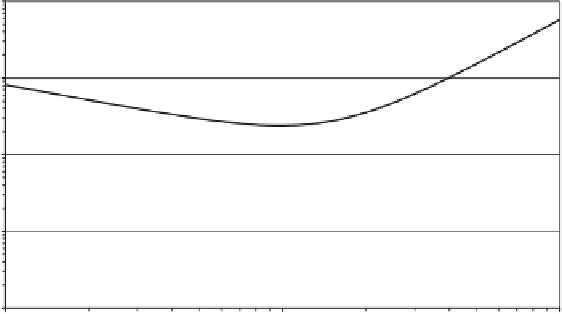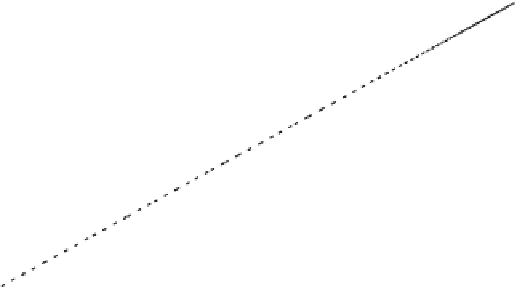Environmental Engineering Reference
In-Depth Information
dk
= effective grain size in metres,
n
= porosity,
γ
= fi ltration effi ciency of a single
collector,
α
= collision effi ciency,
γ
D
= diffusion,
γ
I
= interception,
γ
G
= gravitation/
sedimentation,
S
= sieving,
kB
= Boltzmann constant in J/K,
T
= absolute tempera-
ture in K,
vf
= apparent fl ow velocity in m/s,
dp
= colloid size in m,
g
= gravitational
acceleration in m
2
/s,
γ
p
= colloid density in kg/m
3
,
µ
= dynamic viscosity in kg/m/s,
ρ
W
= fl uid density in kg/m
3
,
AS
= Happel parameter and
AH
= Hamaker constant
in J.
Figure 4.18 shows the sum of the four different CFT mechanisms to the total
fi ltration/deposition curve. A typical minimum in colloid fi ltration in porous media
can be observed at 1
ρ
m for colloids with a density of 1 g/cm
3
. In Figure 4.19 the
effects of sediment grain size, fl ow velocity and colloid density on travel distance
until 99.9% of all colloids are retained are shown. The grain size of the collector
itself has a very strong effect on colloid retention in porous media. A ten-fold larger
grain size leads to an increase of maximum travel distance from 40 cm to 15 m
(gravel = 10 mm vs sand = 1 mm grain size diameter). An increase in colloid density
from 1 to 3 g/cm
3
reduces the maximum travel distance from 30 to 12 m. Note that
density is only important for colloids
µ
100 nm, below 100 nm there is no effect of a
change in density from 1 to 3 g/cm
3
. A reduction of the fl uid fl ow velocity from 10
to 1 m/d (representing typical values for aquifers) reduces the maximum travel
distance from 200 to 30 m. Maximum colloid mobility can be expected at a size
range close to 1
>
m for colloids with a density of 1 g/cm
3
and around 0.2
µ
µ
m for
colloids with a density of 3 g/cm
3
.
It is important to notice that the CFT holds for a clean bed fi ltration approach,
where the collision effi ciency (i.e. the rate of successful attachment) is close to one
(Ryan and Elimelech, 1996). Ripening or blocking, as well as surface heterogene-
ities of the collector (e.g. roughness or charge heterogeneity), cannot be described
with these equations (Elimelech
et al.
, 2000 ; Johnson
et al.
, 1996b ). Neither can
fi ltration under non-favourable, repulsive conditions, marked by an energy barrier
(Section 4.5 ).
100
10
1
diffusion
interception
sedimentation
0,1
sieving
0,01
0,1
1
10
Colloid Size [µm]
Figure 4.18
Colloid fi ltration by diffusion, interception, sedimentation and sieving.




















Search WWH ::

Custom Search